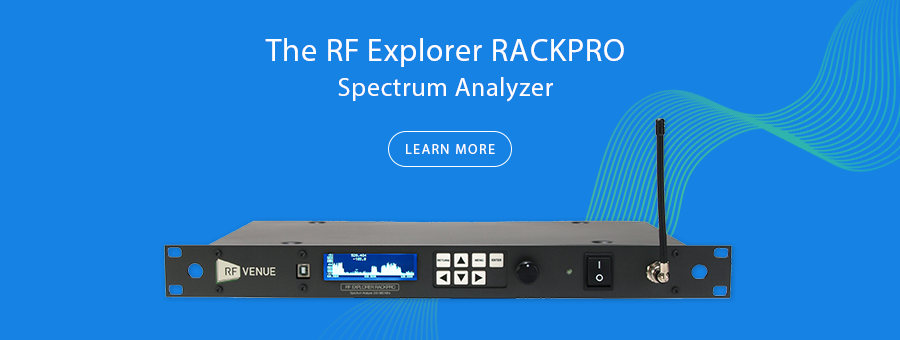- Products
- All Products
- RF PA Extension Kit
- Wireless Microphone Upgrade Packs
- In-Ear Monitor Upgrade Packs
- Wireless Microphone Antennas
- Wireless In-Ear Monitor Antennas
- Antenna Distribution for Microphones
- Antenna Combiners for In-Ear Monitors
- Multi-Zone Antenna Combiners
- Spectrum Tools
- Accessories, Cables and Parts
- Solutions by Venue
- Resources & Training
- Performance Tools
- About Us
December 15, 2014
The Godfather of WiFi Wants Wireless Microphone Users to Pay for Spectrum
Written by: Alex Milne
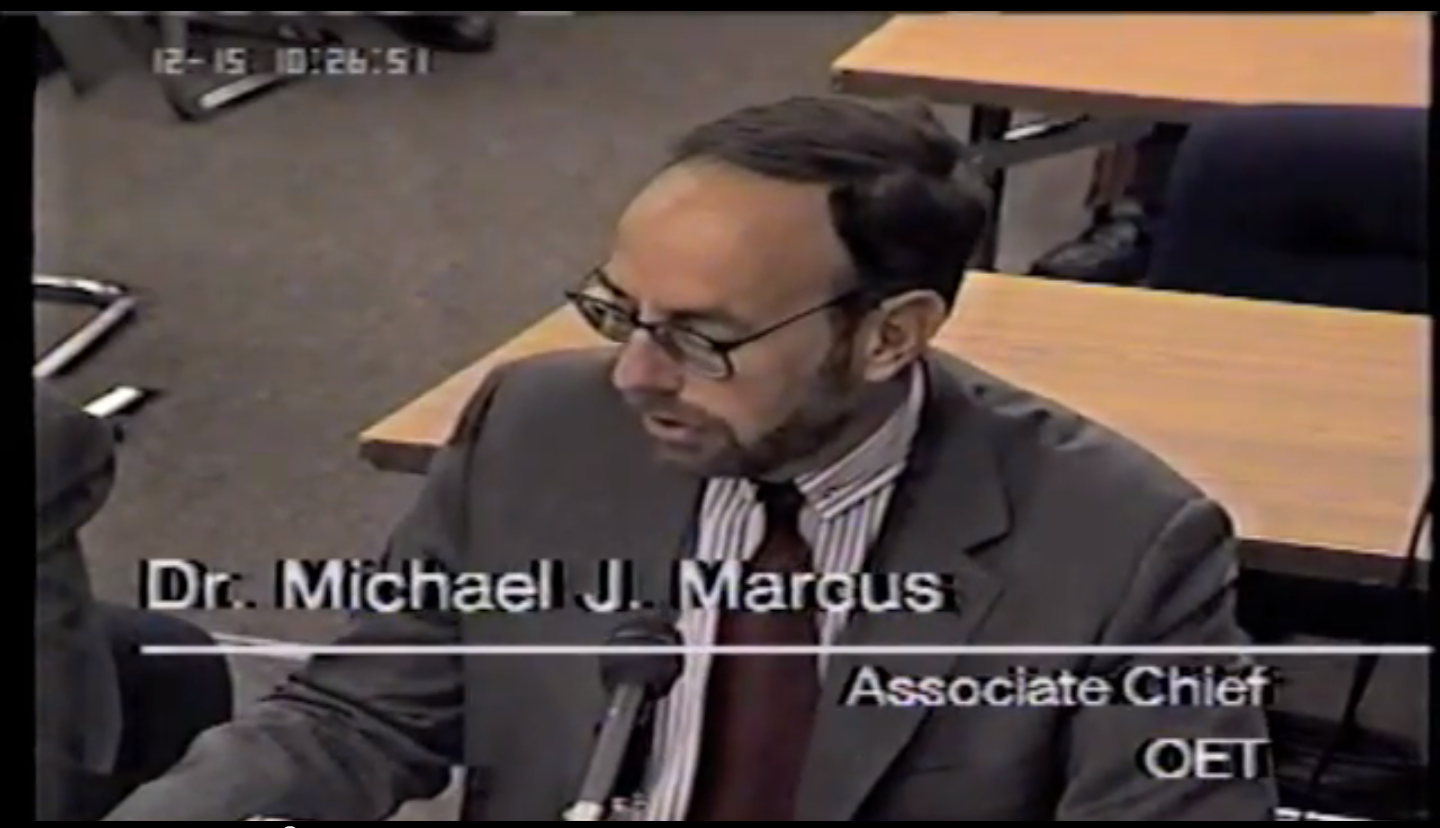
Michael Marcus knows a thing or two about wireless. His contributions to regulations and technologies in the 80s (that went on to become millimeter waves, Wifi, and other technologies) are, to some, the stuff of legend. In a 2004 article, the Economist described Marcus as the “visionary engineer” whose foresight opened the gate for WiFi. His other laurels are numerous.
Over the past few years, Marcus has voiced concern over wireless audio’s use of TV band spectrum, and proposed frameworks for resolving the wireless audio industry’s spectrum woes while simultaneously enabling more efficient utilization of UHF spectrum.
One of his ideas is to have users with high channel counts (broadcast events, large concerts, etc) lease spectrum from cellular carriers and operate with a modified radio technology that allows high fidelity, real-time operation. Among all the ongoing discussions and proposals on the future of wireless microphones, Michael Marcus’ voice is unique. Although there is considerable controversy on this topic, the least we can do is hear him out and recognize that many of his arguments are plausible.
Marcus received a doctoral degree from MIT in 1972. He worked for the USAF and Institute for Defense Analyses, before becoming Chief of the Technical Analysis Division at the FCC’s Office of Science and Technology in 1981. He remained in this role until 1985, when he was booted for political reasons. He worked in FCC on radio enforcement matters, like finding satellite jammers such as " Captain Midnight," then returned to his old office after several years until retiring in 2004. During his public sector career he pushed a series of regulatory changes that much of our wireless infrastructure now depends upon, including the 2.4 GHz, 5.8 GHz, and 900 MHz unlicensed ISM bands.
Over the past few years, Marcus has voiced concern over wireless audio’s use of TV band spectrum, and proposed frameworks for resolving the wireless audio industry’s spectrum woes while simultaneously enabling more efficient utilization of UHF spectrum.
One of his ideas is to have users with high channel counts (broadcast events, large concerts, etc) lease spectrum from cellular carriers and operate with a modified radio technology that allows high fidelity, real-time operation. Among all the ongoing discussions and proposals on the future of wireless microphones, Michael Marcus’ voice is unique. Although there is considerable controversy on this topic, the least we can do is hear him out and recognize that many of his arguments are plausible.
Marcus received a doctoral degree from MIT in 1972. He worked for the USAF and Institute for Defense Analyses, before becoming Chief of the Technical Analysis Division at the FCC’s Office of Science and Technology in 1981. He remained in this role until 1985, when he was booted for political reasons. He worked in FCC on radio enforcement matters, like finding satellite jammers such as " Captain Midnight," then returned to his old office after several years until retiring in 2004. During his public sector career he pushed a series of regulatory changes that much of our wireless infrastructure now depends upon, including the 2.4 GHz, 5.8 GHz, and 900 MHz unlicensed ISM bands.
In an oft cited example of government myopia, the FCC regarded the 2.4 GHz and 5.8 GHz bands as “garbage” with no commercial potential. Very few of his contemporaries in private and public sectors realized the potential of his ideas. Yet the seeds Marcus sowed there would go on to grow thousands and thousands of wireless technologies worth untold billions of dollars.
A decade later, Marcus won the inaugural IEEE Electrotechnology Transfer Award for "his pioneering work in the conception, drafting, and enactment of the Federal regulations that legalized commercial spread spectrum radio under FCC Part 15, the rules governing unlicensed devices."
Dr. Marcus was kind enough to spend a few hours on the phone with me, discussing unlicensed spectrum, cellular technology, and the “problem,” as he puts it, of wireless microphones and current TV band regulations.
At the heart of his concern is that most commercial users need to pay to use electromagnetic spectrum if they want access to the broadband, real-time, high fidelity performance their systems currently require.
“Some segments of the wireless microphone industry are big money makers, like concerts and broadway shows,” Marcus points out. “They apparently missed the message in late 1990s that people who use spectrum to make money don’t get a free ride. If you’re using spectrum to make money, don’t expect free spectrum.”
Marcus explains that, historically, wireless microphone operation in the UHF broadcast band made a lot of sense when that band was organized around the NTSC standard. The rules at that time were built around the performance characteristics of analog TV stations. In any given area, only about one in every six channels could be used, leaving a lot of empty spectrum.
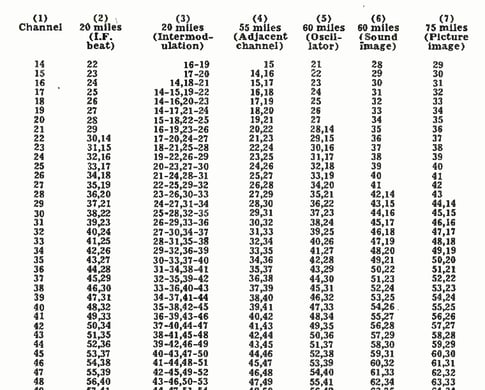 Table from the original 1952 Report and Order outlining mileage separation requirements for analog TV stations - what are now known as the "UHF Taboos," since they were based on interference limitations of current technology that quickly become obsolete.
Table from the original 1952 Report and Order outlining mileage separation requirements for analog TV stations - what are now known as the "UHF Taboos," since they were based on interference limitations of current technology that quickly become obsolete. “The low power sharing of interstitial channels made great sense ,” says Marcus, “because there was nothing else it could have been used for. There was no opportunity cost for wireless microphone use of vacant channels. All of that changed with the move to DTV and the growing demand for cellular spectrum.”
After NTSC was phased out, the HDTV standard packed channels much closer together. Simultaneously, the social and economic value of using TV band frequencies for wireless microphones atrophied in comparison to using those same frequencies for cellular and mobile broadband.
Even the staunchest wireless microphone enthusiast is at odds to assume OTA TV and wireless microphones are using beachfront spectrum in a way that is more valuable and efficient than mobile broadband might.
But as the recent Sennheiser Petition for Reconsideration mentions, most vocal users are not asking to continue using all of the UHF spectrum they use now - the bulk of it should go to mobile broadband - they’re only asking for a small slice of what they used to use.
“The industry is working hard to move non-critical applications out of UHF, and to pack more microphones into every available slot of UHF spectrum,” the petition reads. “Still, at least for some hypercritical applications, past and foreseeable innovation does not eliminate the need for the particular propagation characteristics available only in UHF... We ask that both channels be made available exclusively for wireless microphones." ("two channels" refers to both channel 37, now reserved for medical telemetry and radioastronomy, and the "naturally occurring white space channel.")
Sennheiser echoes many in the broadcasting industry who question eliminating the two reserve channels currently set aside for wireless microphones, amid broader concerns over evaporating UHF spectrum. They assert that, even with registration priority available to Part 74 users through a database that eliminates the possibility of interference from white space devices (which takes 15 minutes to kick in), nothing less than exclusive use of two blocks, especially in urban areas, each between 4-6 MHz post-auction, is acceptable for split-second coverage of breaking news and "hypercritical" applications.
Marcus agrees that some spectrum should be put aside for breaking news ENG (and a small number or priority concert wireless audio devices), but he thinks the amount of spectrum required is on the order of 1-2 MHz, not 4 MHz or more, and should be open to churches, conference rooms, and other users with need for a small number of channels as well. For such small users the transactions costs of accessing spectrum through a commercial system would be burdensome.
“The problem I’m concerned with in the recent proposal for wireless microphones of four or more megahertz that in 99.9% of the U.S. 90% of the time is not going to be used. It’s going to be very heavily used within a block or two in Central Park, and at the Burning Man Festival for a week or so, and that’s a real problem. The challenge in using spectrum efficiently is trying to match demands with resources. Already we have large blocks of spectrum in many bands that are lightly used even though they have allocations and licenses. Earmarking spectrum like that tends to result in underutilized spectrum.”
A tiny dedicated band for microphones makes sense because, on a macro scale, the sum of that spectrum will be in use a greater percentage of the time in a greater percentage of the country. The more spectrum you put aside for this purpose, the less likely that spectrum is to be used. For the larger users who need dozens or hundreds of channels, Marcus has some harsh words: “they’re big guys, they can pay, just like PMSE users pay for spectrum access in UK.”
Of course veterans of the 700 MHz auction will recall UHF spectrum, even small bits of it, is very expensive. Two blocks with a total of between 8-12 MHz might be worth around $1.8-2.7 billion, based on the $227 million each megahertz went for in the 700 band.
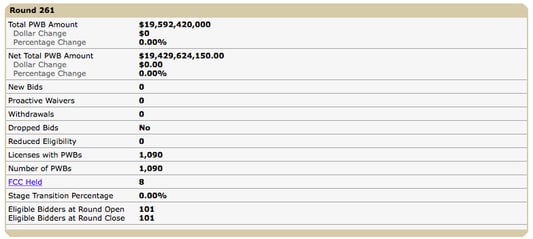
Results of the 700 MHz auction.
“I don’t necessarily disagree with the idea that if you want to use spectrum, you pay for it,” says Henry Cohen, Senior RF Design Engineer at CP Communications. “But can our industry afford the going rates? Not at what the auction is going for.”
Auctions are a visceral proving ground for free market capitalism. Whatever 600 MHz ends up going for, that price is supposed to be a reflection of the value auction participants ascribe to it for real economic reasons.
If the wireless audio industry and the other industries that rely on wireless microphones cannot raise the necessary capital to purchase spectrum outright, their use is less valuable to society than whatever the winners of the auction end up using it for - or so the capitalist reasoning goes.
In the case of the UHF broadcast band, the wireless audio industry, and to some extent the OTA TV broadcasters, have failed to demonstrate their applications are more valuable than mobile broadband in the current political climate. That is not to say these services are not valuable, which they certainly are, but that under the current system those services will probably be displaced. Does this represent a failure of the free market? Possibly. Is there a way to preserve the public use principle of the UHF broadcast band while still allowing mobile broadband to operate? Perhaps, but at this point it doesn’t seem very likely.
So if the writing is on the wall for UHF spectrum (the outcome of the NAB lawsuit will reveal the writing), and even small slices of spectrum are way out of budget for a cross-industry coalition of wireless audio manufacturers and power users, what is to be done?
Well, for some time, Dr. Marcus has mentioned the possibility of leasing spectrum from cell carriers and deploying a protocol to allow wireless microphones to operate on a large number of dormant frequencies.
In a February, 2011 post to Marcus’ excellent blog, he discussed the promise of a new technology to support on-demand wireless microphones on leased cellular spectrum originally developed as a research project by Qualcomm, called FlashLinq:
" FlashLinq is a synchronous TDD OFDMA technology operating on dedicated licensed spectrum and is distinguished by its high discovery range (up to a kilometer), discovery capacity (thousands of nearby devices) and distributed interference management… Sources at Qualcomm have confirmed that it is the underlying technology of the cryptic Qualcomm presentation in Brussels in October 2010 on alternative wireless mic technology that would have a quantum jump in spectrum efficiency over the archaic wideband FM embraced by present wireless mic manufacturers and users… Now that an alternative wireless mic technology has a major player behind it, we hope that FCC and people interested in UHF spectrum start pressing harder for an orderly phase out of wideband FM except for small users who need only a handful of audio channels. "
Marcus thinks a technology like FlashLinq will let wireless microphones access practically unlimited spectrum instantly and seamlessly.
“In a cell system, inevitably, there is always free spectrum that can be used if you keep the power low.” He draws an analogy to femtocells, which are low-power base stations that increase network capacity by operating at low power and relatively short distances to exploit slack inherent in high power base-station coverage. “A cellular system in any spot is not using its whole spectrum. Just like you can put wireless microphones in vacant TV channels, you can put low power transmitters in that space in a cell plan.”
Marcus wonders if FlashLinq itself is “abandoned or virtually abandoned” by Qualcomm, but still thinks operating a tailored, short distance femtocell-esque technology on leased cellular spectrum is possible. “If you have a cellular license in the US, you can use it for almost anything under the sun. The US cellular rules are amazingly, amazingly flexible.”
Besides the more obvious challenge that nobody, nobody, who uses a wireless microphone wants pay-to-play, there is another problem: the wireless microphone user base is very small compared to the volume of units cell networks and technology providers, like Qualcomm, are accustomed to profitably dealing with.
“I’m fascinated by the concept,” says Cohen, on using FlashLinq for wireless audio. “It’s something we in this industry have to look at. But the entire business model has some significant challenges to it. The amount of money that would make it worth AT&T or Verizon’s while to expend time and energy to implement such a system would be cost prohibitive to us. The cell companies are dealing with hundreds of thousands or millions of subscriber units at any given instant in time… [Wireless audio is] an extremely small potential revenue stream.”
A few days earlier, Dr. Marcus told me the same story using different words. “The cellular industry doesn’t want anything to do with you, and you don’t want anything to do with them! For different reasons, neither side wants anything to do with the other. But the cell phone industry should look at wireless mic users not as a potential source of a small amount of revenue that may not be worth their while, but rather as a competitor for scarce spectrum access. By offering FlashLinq-like service to wireless mic users they could gain some small revenue and eliminate a competitor for spectrum - their life blood!”
For many, the motivation for switching to a leased model is hard to find. The most difficult thing about adopting a concept like Marcus’ is that it involves reinvestments in new technology, even though those investments could potentially pay off in the long run to transition the industry onto a more sustainable business model. In recent years all consumer TV systems have transitioned to new DTV technology and Part 90 mobile systems are nearing the end of a transition to narrowband technology. So such transitions are not unsual for spectrum users.
Marcus also points out in a 2012 post during the London Olympics that in the United Kingdom, regulators have required professional wireless microphones to register and pay for their frequencies for quite some time, with no ill effect.
" Watching the Olympics, you might not have noticed an interesting spectrum policy point: Wireless microphones (mics) are being used widely without any technical problems in a spectrum policy environment very different from the US: wireless mic users like most other spectrum users in the UK (including military users) are paying for spectrum access! […] In the UK, Ofcom’s “dedicated band manager” for “programme-making and special events”/PMSE is JFMG… JFMG buys spectrum at market prices and then leases it for PMSE uses such as wireless mics to users who pay according to the amount of resources they use. "
If broadcasters and other hypercritical business users are able to lease frequencies while still remaining profitable in the U.K., professional users in the U.S. should be able to figure out a way to pay for spectrum, too, without running their organizations into the ground or compromising the technical quality of their productions.
“Charging for spectrum in the U.K. has not resulted in the day the music died,” Marcus claims.
While at first glance, paying for spectrum, no less transitioning all licensed users to a new radio technology, seems to border on insanity - when you consider the current regulatory climate, rampant uncertainty, ubiquitous interference, and all the other lukewarm options at hand, pay-to-play becomes, at the very least, one of many plausible alternatives.
“I would love get someone at the cellular companies interested in this, to see how we could facilitate it,” Cohen dreams. “Because we’re going to have to pay for spectrum, end of discussion. It’s really that simple and straightforward. Spectrum is too valuable a commodity, and the free ride is over.”
At the end of our phone call, Dr. Marcus told me his first impression of the incentive auctions: “I said ‘this is crazy.’ It’s grown on me since then. My friends who are involved say it is unprecedented. But you know, let me say I was personally involved in the creation of what became WiFi, and that was unprecedented, too. The unprecedented takes a little longer to sink in.”
Alex Milne
Alex Milne was Product Marketing Manager and Digital Marketing Manager for RF Venue, and a writer for the RF Venue Blog, from 2014-2017. He is founder and CEO of Terraband, Inc., a networking and ICT infrastructure company based in Brooklyn, NY., and blogs on spectrum management, and other topics where technology,...
More from the blog

2.4 GHz CP Beam
Broncos Stadium Upgrade a Case Study in Temporary, Event Specific Spectrum Crunches
4 min read
| December 14, 2014
Read More

Knowledge Guides
Big Changes for Wireless Audio Industry in Store, Reveals New FCC Document
7 min read
| December 15, 2014
Read More
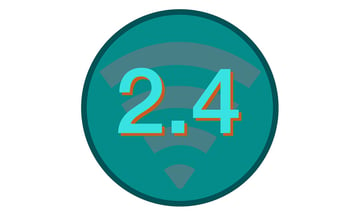
2.4 GHz CP Beam
Everything You Need to Know about 2.4 GHz Wireless Microphones
5 min read
| January 27, 2015
Read More
Subscribe to email updates
Stay up-to-date on what's happening at this blog and get additional content about the benefits of subscribing.

